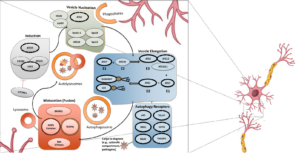Loss of TECPR2 function has been implicated in an array of neurodegenerative diseases, but what exactly is that function? Understanding TECPR2 function is essential for developing precision diagnostics and targeted treatment options for TECPR2-related neurodegenerative diseases. Therefore, we leveraged the increasing amounts of functional genomic data to perform a first comprehensive functional characterization of TECPR2. We report that TECPR2 might play a role in regulating the balance between protein synthesis and autophagy, which could be informative for neurodegenerative diseases, including Alzheimer’s disease, Huntington’s disease, and spastic paraplegias. We further link TECPR2 to the later stages of autophagy and show that its expression patterns are consistent with a neurodevelopmental function. We finally show that this function is non-redundant, as supported by population-wide genomic variation data. Our results imply that TECPR2 may play a role in regulating synaptic proteostasis, and its dysregulation might serve as a marker for neurological disorders. (By Dr Alal Eran, https://jmg.bmj.com/content/early/2021/12/20/jmedgenet-2021-108193 )
A scheme of autophagy and the main proteins involved in each autophagy stage. Proteins that are directly associated with TECPR2 are highlighted by thick lines. Proteins that are indirectly associated with TECPR2 are marked by dashed lines. The evolutionary relation between TECPR2 and TECPR1 is highlighted by a double line.
